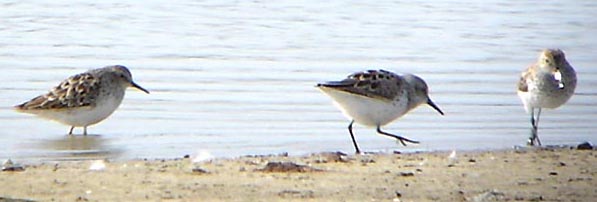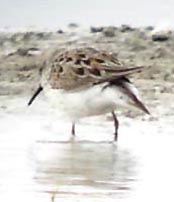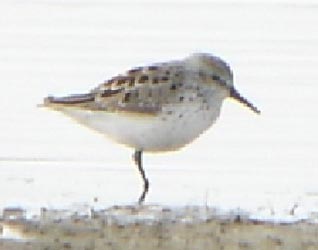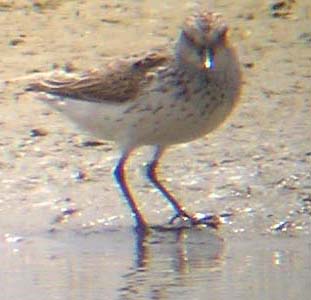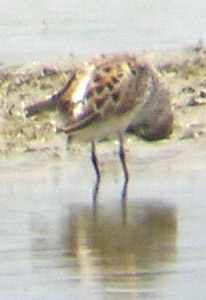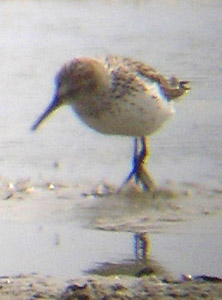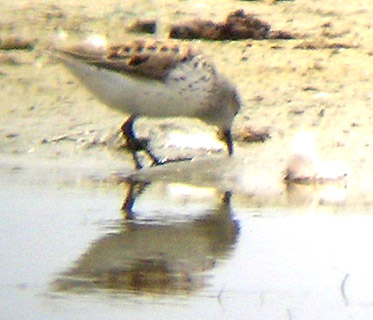 The
bird does have a bit of webbing between the toes, perhaps best seen in
the left-hand of the three shots above (and also confirmed and reconfirmed
several times in the field). The bill was not as stout as would be expected
for Semi, but comparative length can be seen in Fournier's photos (one
can also judge relative size there). In other words, compared to Western,
the bird was small and the bill was shorter. In the scope views the bill
tip looked slightly expanded (not coming to a fine point) and that can
be seen on the photos of the bird facing half-away (but profile shots make
it look fine-tipped). The
bird does have a bit of webbing between the toes, perhaps best seen in
the left-hand of the three shots above (and also confirmed and reconfirmed
several times in the field). The bill was not as stout as would be expected
for Semi, but comparative length can be seen in Fournier's photos (one
can also judge relative size there). In other words, compared to Western,
the bird was small and the bill was shorter. In the scope views the bill
tip looked slightly expanded (not coming to a fine point) and that can
be seen on the photos of the bird facing half-away (but profile shots make
it look fine-tipped).
Of interest were the apparent complete lack of spots or chevrons on
the flanks (none seen at all when it lifted a wing); the size, shape, and
distribution of the spots on the underparts; and the complete lack of rufous
to the new black-centered feathers of the upperparts. There has the barest
hint of red in the tiny feathers of the back (not in the scaps) and a slight
wash of warmth through the face patch and on the crown. According to Jonsson
& Grant (1984) "Identification of stints and peeps" British Birds
77:293-315, that is okay for Semi but, of course, Western had extensively
rusty cheeks and crown in alternate. |
| For comparative purposes, here (right) is a Western Sandpiper that
I photo'd in Pebble Beach on 7 May 2005. |
 |
There are mixed opinions on the mystery bird. Jonsson & Grant (1984)
rely heavily on the pattern of the lower scaps. On that, it is a Semi.
How much variation is there in this character?
Semipalmated Sandpiper occurs annually in fall migration in MTY, but
in very small numbers. Westerns are common spring and fall, and winter
in numbers on Elkhorn Slough. There are only a couple spring records of
Semi for the county, and these were birds with more typically stout, blob-tipped
bills (among other things). |

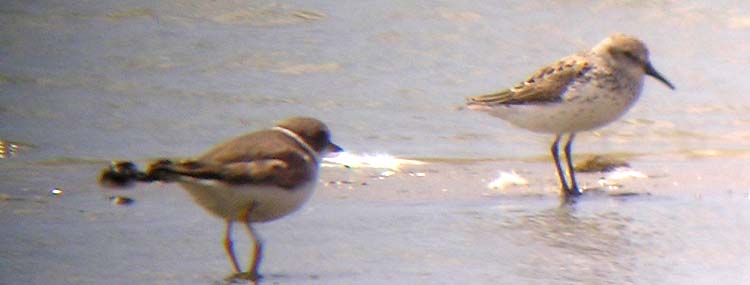
 The
bird does have a bit of webbing between the toes, perhaps best seen in
the left-hand of the three shots above (and also confirmed and reconfirmed
several times in the field). The bill was not as stout as would be expected
for Semi, but comparative length can be seen in Fournier's photos (one
can also judge relative size there). In other words, compared to Western,
the bird was small and the bill was shorter. In the scope views the bill
tip looked slightly expanded (not coming to a fine point) and that can
be seen on the photos of the bird facing half-away (but profile shots make
it look fine-tipped).
The
bird does have a bit of webbing between the toes, perhaps best seen in
the left-hand of the three shots above (and also confirmed and reconfirmed
several times in the field). The bill was not as stout as would be expected
for Semi, but comparative length can be seen in Fournier's photos (one
can also judge relative size there). In other words, compared to Western,
the bird was small and the bill was shorter. In the scope views the bill
tip looked slightly expanded (not coming to a fine point) and that can
be seen on the photos of the bird facing half-away (but profile shots make
it look fine-tipped).
